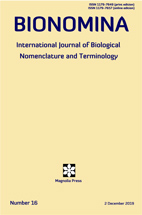Abstract
The neotropical colubrid snake genus Chironius Fitzinger, 1826 comprises 22 species, distributed from Central America, at Honduras, to South America, in Uruguay and Argentina (Dixon et al. 1993; Hamdan & Fernandes 2015); this genus is diagnosed by the presence of 10–12 dorsal scale rows and hemipenis with single lobe and sulcus, centrally spinous, distally calyculate, acapitate and with a proximal naked pocket (Dixon et al. 1993). Chironius laurenti Dixon, Wiest & Cei, 1993 is a large sized colubrid, distributed in Bolivia, at departments of Beni, Cochabamba and Santa Cruz, and in Brazil, in Acre, Mato Grosso and Mato Grosso do Sul (Dixon et al. 1993; Miranda et al. 2014; Ferreira et al. 2017).

